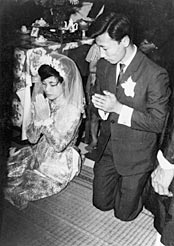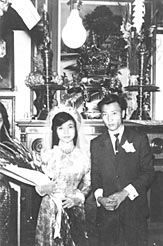
|
| Prayers for their marriage |
Minh Thi & Tien
Author: Mary Ann Hamilton, Getting Married project
Getting Married: Minh Thi and Tien Minh Nguyen met in 1965 in Saigon. They married in a traditional Buddhist wedding and settled down to a new life as a married couple. In 1975 their settled life changed as they began their journey to a new home in Australia.
In the beginning
Working in Saigon
Minh Thi and Tien Minh Nguyen met when Minh Thi started work as a secretary
for her future husband, who was at the time an aspiring and talented young journalist
and publisher. Over the next six months, Tien became increasingly impressed
with and attached to his hard working and pretty secretary, and he eventually
suggested that they marry.
Considering marriage
Despite the fact that Minh Thi had been receiving some special attention from
Tien, who treated her to dinner regularly, took her to concerts, trips to the
beach and picnics in the country, she was quite surprised when Tien proposed.
As an attractive and charming 16 year old she had many suitors at the time from
among the officers in the South Vietnamese army. She was careful not to encourage
these young men
 |
 |
|
(Tien) I had to discourage them – I used to say I was too young
to think about marriage and I did not want to get married until I was about
20 years old!
|
But when Tien proposed, Minh Thi thought very carefully and decided that his
kind and considerate nature was a prize that she could not lose.
Meeting the parents
Before Minh Thi could accept Tien's proposal of marriage she insisted
that she had to take him to her home to meet her parents and gain their approval
for the marriage. In the 1960s in Vietnam the decision to marry was not made
by the young couple alone. Parental approval was essential and in some cases,
especially in country areas, parents arranged the marriage of their children.
Her parents were very impressed with Tien. He fulfilled all their hopes as
a future son-in-law and husband for their daughter. He was good looking, well
behaved, had a stable life and a good job. Having a good job was important in
Vietnam during that time when many people could not find work and struggled
to keep their families in the face of a country torn by civil war.
Getting engaged
Similarly, Tien's parents were delighted by Minh Thi, and with both families'
approval, Minh Thi and Tien became engaged.
 |
 |
|
In Vietnam at that time the engagement is a real commitment
to get married… You wear a ring and people know that you have a future
husband – other boys cannot look at you as you are engaged. Being engaged
is almost the same as being married in Vietnam.
|
Traditionally, Vietnamese engagements are very short to ensure that the girl's
reputation is not damaged. In traditional culture it is only after the engagement
that the boy and girl can see each other freely. While these strict mores had
been relaxed a little by the 1960s, allowing Minh Thi and Tien to spend time
together without censure, they still had a short engagement of three months.
The wedding
Preparing for the wedding
Minh Thi and Tien were married in the traditional Vietnamese-Buddhist way. As
is customary, during the three months before they were married Tien took on
the responsibility to organise and purchase everything for the wedding. The
groom buys all the clothes for himself and for the bride and her family, he
organises and pays for the wedding party and purchases the wedding jewellery.

Just married!
 |
 |
|
These things, the clothes and jewellery, are given to the girl's
family on the day of the wedding. In Vietnam the amount and quality of the jewellery
is important as it shows how wealthy the groom and his family are… If
the jewellery is poor quality people will feel sorry for the family and the
girl. Here in Australia these things don't matter so much.
|
The day of the wedding
On their wedding day in 1965, Tien arrived at Minh Thi's house and was
greeted by her parents. Minh Thi was dressed in ao dai, the traditional
Vietnamese ‘long dress', but instead of the traditional headdress
she wore a white, western-style veil, a fashion that was popular among Vietnamese
brides in the 1960s.
In front of her father's shrine dedicated to Buddha, the couple prayed
and then Tien offered tea to Minh Thi's parents. The gift of wedding jewellery
is then given by the groom to the bride. The couple then visited Tien's
parents' house and repeated these rituals for them. More wedding jewellery
is then given to the bride by members of the husband's family.
Minh Thi and Tien and their families then departed for the reception which
was held in a large restaurant in Saigon. Tien had organised a virtual fleet
of cars to transport not only the bridal couple but their parents and cousins
and uncles and aunts. The bridal car was elaborately decorated with flowers.
The reception
The reception was suitably large and lavish with special dishes of beef and
chicken served to the guests. There was no wedding cake and no dancing as dancing
was seen as a quite immoral activity in Vietnam at the time. There was much
singing though, and MinhThi and her friends sang to entertain the guests and
contribute to the festivities.
Life together
Married life
Many Vietnamese brides at the time went to live with their husband's family.
For some this was not a happy way to start their married life.
 |
 |
|
Some groom-side parents think the bride is their new servant.
The girl has to cook and clean, iron and shop. Some brides who are very beautiful
when they marry loose their looks after a couple of years of marriage.
|
This was not Minh Thi's experience as she and her husband went to live
in his own home where over the next 10 years she bore and raised her two sons
and two daughters.
 |
 |
|
When I married I knew I would have to work hard at my marriage.
I knew I must try to keep peace in my marriage, I was taught that it was not
right for a wife to be angry or to fight with her husband. I try to resolve
conflicts by talking and discussing.
|
Leaving Vietnam
The partnership has been tested through times of great upheaval, when the family
had to leave their war-torn homeland. In 1975, Saigon fell to the North Vietnamese
communist government. When Tien was not able to work, their previously comfortable
life was transformed into one of struggle. The couple decided that to provide
opportunities for their children, they must attempt to escape Vietnam. Months
of separation followed, after Tien migrated to Australia while Minh Thi and
the children were detained in a refugee camp in Thailand. The family was reunited
in Perth in the late 1970s, moving to Sydney soon after to establish themselves
and their new life in Australia.
Over the years they have established a life of relative comfort and security
in Sydney's southwest. Their children have all grown up and married and
they have just celebrated the wedding of their daughter, Michelle, to Vinh Luc.
>
Back to Michelle & Vinh's wedding
> Take a look at some more weddings
|


